Cripple Mister Onion
These rules were reconstructed according to the game depicted in Witches Abroad, a Discworld novel by Terry Pratchett. The modifiers were developed in conjunction with Terry Tao.
Adjusted to the applet version of the game by Raphael Kirschke
This version of the rules for Cripple Mr Onion consists of five parts:
Contents:
- Introduction,
- The Hands,
- The Game,
- The Modifiers,
- Additional Comments.
1. Introduction:
Back
This version of Cripple Mr Onion is played with a "real" Discworld deck of playing cards with eight suits. wird hier mit einem "echten" Scheibenwelt-Blatt aus acht Farben gespielt. Jeweils zwei Farben gehören (für Flushes Suits with the same colour make up pairs for the purpose of forming flushes and similar combinations.
| white |
Elephant |
Crown |
| blue |
Octogram |
Cup |
| red |
Turtle |
Coin |
| black |
Staff |
Dagger |
The game also requires at least two players, but not more than seven — this isn’t to do with the number eight for a specific reason, but a result of the fact that there aren’t enough cards for more than seven players. Each player starts this game with one Ankh-Morpork dollar.
2. The Hands:
Back
Cripple Mr Onion revolves around forming groups of cards which either sum exactly to twenty-one (an onion) or come close to this total without exceeding it; in the usual fashion, a picture card (P) is worth ten, an ace (A) is worth one or eleven, and other cards are worth their face value: a ten (T) is worth ten, a nine is worth nine, and so on. Since groups of cards which sum exactly to twenty-one can be formed in various ways, they are ranked in a particular order according to their composition, along with a few other groups which do not give twenty-one in total but which are of some interest; these special hands, described below, are worth more than any other valid combinations of cards and usually dominate the play.
There are fourteen categories of winning hands and in increasing order of worth are::
- Any cards: Anything which does not fit into one of the following categories. The higher the sum of the card's values, the more valuable the hand.
- Bagels: this is a combination of two cards which totals exactly twenty; it is, therefore, one of TT, TP, PP or 9A. Zwo bagles are called a double bagle, three a triple, four a lesser and five a great bagel.
- two-card onion: this is a combination of two cards which totals exactly twenty-one; it is, therefore, either TA or PA.
- Broken Flush: this is a group of at least three cards, summing to at least sixteen (but not more than twenty-one) with all of the cards except for one in the same suit-pair (see table).
- three-card onion: this is a group of three cards which totals twenty-one exactly; examples are ATT, 56T, and 579.
- Flush: this is a group of at least three cards, summing to at least sixteen (but not more than twenty-one) with all of the cards in the same suit-pair (see table).
- four-card onion: this is a group of four cards which total twenty-one; for example, A55T, 2469, and 3378.
- Broken Royal: this is a special case of a three-card onion where the three cards are specifically 678 (of any suit-pairs).
- five-card onion: this is a group of five cards which total twenty-one; for example, A235T, 23466, and 33348.
- Royal: this is another special three-card onion being 777.
- six-card onion: this is a group of six cards which total twenty-one; for example, A2233T and A23456.
- (Wild Royal: this is a combination that may only be played when eights are wild — see the modifiers for details — since it consists of three wild eights.
- seven-card onion, for example, A223445.
- Onion: an Onion (capitalised letter ‘o’) is a two card combination of a picture card and an ace; however, PA on its own is just a two- card onion (place two above), since to occupy this exalted position, the group must consist of two Onions, PAPA or Double Onion, or three Onions, PAPAPA or 3[PA] or Triple Onion, or four Onions, 4[PA] or Lesser Onion, or even five Onions, 5[PA] or Great Onion. The Onions themselves are arranged according to their worth, with Double Onion the lowest and Great Onion the highest.
Notice that the maximum number of cards making up an onion is seven (there is no eight-card onion) and that for PA to be of any real value, the player must hold at least two picture cards and two aces.
Since each player is ultimately in possession of ten cards, a number of groups, most of them usually winning hands, can be formed; the objective of any individual player is therefore to form the ten cards into the best possible set of groups, with each of the ten cards taking part in only one of the groups. For example, representing clubs and staves by ‘c’, spades and swords by ‘s’, hearts and cups by ‘h’ and diamonds and coins by ‘d’, the hand:
3c 3s 4s Js Ah 7h Qh Ad 4d 6d
is best split into:
Double Onion — JsAhQhAd
five-card onion — 3c3s4s4d7h
a six — 6d
whilst the hand:
9c 4s Qs Ks 4h Jh Ad 7d Td Kd
is best split into:
four-card onion — Ad4s7d9c
double bagel — QsKsJhTd
a fourteen — 4hKd.
From this list of winning hands, it follows that some cards are intrinsically more valuable than others: tens, for example, are only useful in bagels and small-card onions whereas twos and threes are necessary for constructing many-card onions; aces and picture cards are obviously of great value. However, a player’s strategy in selecting cards for replacement (see the game descriptions and certain of the modifiers) should also be influenced by the number of players, and whether eights are wild or not, since these factors influence the relative likelihood of each hand winning the round.
3. The Game
Back
3.1. Betting
There are two types of betting that are used in the gambling version of Cripple Mr Onion and these will be described before the details of how they fit into the game are given.
The first type is "matching the Dealer’s stake". First, the Dealer chooses a number of coins or tokens to be the stake, on the basis of the cards known to the Dealer, and, naming the amount, places it in the Pot; if the Dealer wishes, the amount may be zero. Then, when called upon by the Dealer to do so, each player must either match the stake, placing an equal amount in the Pot, or fold, placing all cards in the discard pot and losing any claim to the Pot in that round; of course, if the stake is zero, all remaining players can stay in for free.
The second type is "raising the Dealer". When called upon by the Dealer, each player may choose to make an extra bet against the Dealer, according to cards that are known to that player. If the player chooses to raise, the chosen number of coins or tokens are placed on the player’s cards and the amount is named. Finally, when all the players who have not yet folded have done this, the Dealer must place an amount equal to the total value of raises into the Pot — and all the individual raises then go into the Pot as well — or lose the Dealership: often this means that the Dealer must fold.
The player who startet the game automatically becomes the Dealer. The one who entered second is the Elder, and the one who entered last is the Younger - this sets the order of precedence in being dealt cards and in winning in the event of a tie as Dealer, Elder, other players in order and, lastly, Younger. In the event that the Dealership changes, these identifiers move to be based around the new Dealer.
Every player places five cent (the Stake), into the Pot as the ante and is then given five cards. Then, in turn, from Elder to Younger, each player discards up to four cards into the discard pot, which are replaced with new cards from the top of the pack. It is important to note that up to this point all cards have been dealt face down, each player is only aware of their own cards and, by way of the draw, ought to have a better hand than was originally dealt.
The Dealer selects a stake, as described above, and then, from the Elder to the Younger, asks each player first to match that stake and then to raise it; if the Dealer cannot match the total value of the raises, then the Dealer folds. This matching and raising occurs twice. The Dealer then selects a stake for the third time and again asks each player, in order, to match it; this time, however, the players are not asked to raise.
The second set of five cards for each remaining player is then dealt as follows: as before, the Dealer receives five cards face down, but now each player has the option of buying from one to all of the five cards face down, at the price of an amount equal to the Stake per card, instead of receiving them all face up. The Dealer deals the remainder from the five to that player face up on the table in front of the player. As each player receives the full complement of ten cards, an extra bet may be made, in the same manner as raising the Dealer, and then, once every remaining player has ten cards, the Dealer must consider all the extra bets.
If the Dealer matches the total extra bets made, the game continues with the second round of betting described below; however, if the Dealer does not wish to match the extra bets, then the Dealership changes without the Dealer folding — this is the only time when this can take place. The Dealer gives the Dealership to the Elder who, to become the new Dealer, must match the total extra bets, the Elder’s own extra bet going into the Pot if the Dealership is accepted; of course, if the Elder does not accept, the Dealership is passed left again until one of the other players accepts it, or until it has gone full circle with no-one wanting it — in that case, everyone folds, the Pot becomes the ante for the next round, the old Dealer remains as Dealer, and the next round starts afresh.
Once the extra bets have been matched, be it by the original Dealer, the Elder or one of the other players, the second round of betting takes place. This consists of two stages of matching and raising as in the first round of betting, but now not followed by a third stage of matching only.
Now the final part of the round, Showdown, takes place. Beginning from the Elder, the highest card grouping is declared and displayed on the table; if the player to the left of the Elder cannot equal, beat or play some modifier that affects the Elder's cards, that player's cards are all placed face up on the table, in their groupings if the player wishes, and that player is out of the round; the comparison of the next leftward player's cards with the Elder's then takes place. If the Elder's cards are equalled, then the next card grouping must be considered. If the Elder's cards are beaten, then the Elder has the opportunity to play a modifier or rearrange the card grouping in an attempt to obtain a better arrangement; once the Elder's cards are undoubtedly beaten, however, the Elder is out of the round and the comparison of the currently leading player's cards with the next leftward player's takes place. By this process of comparison, consideration of lower groupings, rearrangement of card groups and playing of modifiers, and knocking out of players, the holder of the best set of cards, between the Elder and the Younger, is found. Finally, the Dealer's cards are compared with the only player left in, and the process of finding the better cards is repeated; the player who holds the better cards has then won the game and claims the contents of the Pot as the prize for winning. Note that in the event of either a complete tie between two players' cards or an impasse due to circular use of modifiers, the player of greater seniority wins — often, this means that the Dealer wins. Once all the players but one have been knocked out, leaving the winner holding the best cards, the round is over, the cards and discards are collected up and the winner becomes the Dealer for the next round.
4. The Modifiers:
Back
The modifiers have usually been created for one of two reasons, either to make the game a little more interesting and a little more uncertain, or to decrease the chances of winning with a specific hand. It is not necessary to use any of them, apart from numbers zero, which gives the game its name, and one, which makes many-card onions and then Onions more probable, and in a game, say, between four hardened professionals, even the Null Eights Rules would probably not be used. As of now, however, in the online version of the game all of the modifiers are always enabled.
Most of the rules are activated by "declaring" a card. This means, the card is put face-up on the table and is thus shown to the other players. Declared cards can still be used to build to create card groupings, unless, of course, the rule requires this card to be exchanged, as in the Lady's or Fate's rules. It is not possible to declare cards which are already revealed to the other players - this means especially cards that have already been dealt face-up.
Other rules are activated automatically by having this card "visible". In this case, no declaration is necessary: The rule is active from the moment the face of the card is visible. This can happen by playing the card in a combination or by having it dealt face-up.
Whenever a rule is activated at the time of the showdown, it can be necessary for both of the involved players to start the showdown from the beginning, because the activated rule might have changed the possible card groupings.
The modifiers are all, some to a greater extent than others, based on Discworld life, mythology and beliefs and have been assumed to have evolved, with the game, over many centuries; none of the modifiers are arbitrary in their action or purpose, but a detailed knowledge of the Discworld is not necessary to use them. Finally, the ordering of the modifiers in the list below is, apart from the Crippling Rules in position zero, largely accidental and is not a guide to their usefulness or effectiveness.
Modifier #0: Crippling Rules
- "Lesser Crippling": A nine-card running flush may be used to cripple a Great Onion and win the game.
A ten-card running flush out-cripples a nine-card running flush in crippling a Great Onion and may also cripple a Lesser Onion.
- A ten-card running flush out-cripples a nine-card running flush in crippling a Great Onion and may also cripple a Lesser Onion.
(Once a Great Onion or Lesser Onion have been crippled, the usual process of Showdown stops, and the player with the crippling hand wins immediately.)
Modifier #1: Null Eights Rules
- During a round in which eights are not wild (see below), an eight may be used as if it had value zero in order to trump up an onion. In the event of a tie between two onions with equal numbers of cards, the onion with the fewer null eights wins.
- In the round following a round in which a null eight has been played, eights are wild, acting as any regular card. The wild Royal, three wild eights, may then be played. In the next round, eights return to their original role.
(To “trump up an onion” means to make a four-card onion into a five-card onion by the addition of one null eight, or to make a three-card onion into a seven-card onion with four. Note, again, that there are no onions beyond seven-card and that wild eights cannot be used as either null eights or as any of the special cards giving rise to later modifiers.)
Modifier #2: Wild Crippling Rule
In a round in which eights are wild, to successfully cripple the relevant Onion, the running flush must have at most the same number of wild cards as the Onion being crippled.
Modifier #3: Octavo Rule
When eights are wild, the card group consisting of eight eights can be considered as a Lesser Onion, but beats other Lesser Onions and may not be crippled like a Lesser Onion of any other composition, but may be crippled like a Great Onion.
Modifier #4: The Lady’s Rules
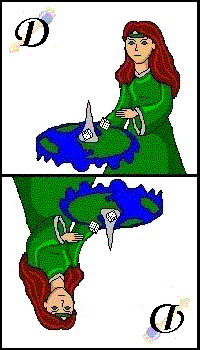 | - If eights are not wild, the Lady may be declared, before or during Showdown, and replaced by the player’s choice of one of the next two cards from the deck, the chosen card taking up the place of the queen; the other card goes to the discard pot. This move may not be rescinded.
- When eights are wild, the Lady may be declared in order to devalue one ace, for every other player, that would otherwise be played as having value eleven, to value one only. (Each player gets to choose which ace in particular is devalued.) This does not affect any aces in a Great Onion, but may affect cards, in any grouping, which, by being wild or by other means, would otherwise be played with value eleven.
|
Modifier #5: Fate’s Rules
 | - If the Lady has been declared and replaced, Fate may also be declared and replaced in a like manner, in the process making all aces held by the player who used the Lady have value zero.
- If eights are wild, Fate may be declared so that eights immediately cease to be wild; a different player who has the queen of spades, whether visible, played or not, may then make his own eights wild again. Fate may not be revoked once declared, and a single player may not use Fate and the Lady in this way.
("Zeroed" cards are of no use in the game, and cannot be used like null eights to trump up an onion.)
|
Modifier #6: Great A’Tuin’s Rule
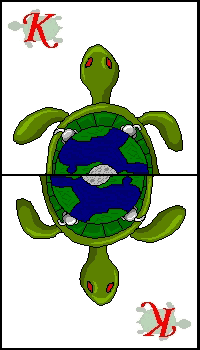 |
Declaring Great A’Tuin allows the player to reduce the value of one of the player’s cards by eight points and to increase the value of a different card by eight points. The two affected cards must still have value between one and eleven inclusive.
(A two that is shifted up to value ten may be considered a picture card, a three shifted up to eleven as an ace of value eleven.) |
Modifier #7: The Elephants’ Rule
 |
Any four cards, each being either a nine or a ten, or an eight when eights are wild, that are declared together with Great A’Tuin, allow that player to shift as many points as are needed to generate a Double Onion. This Double Onion may be beaten by any other Double Onion. Any nines or tens in the player’s hand that are not involved in the shift may be considered as ones, not aces, and twos respectively.
(Since the five cards involved here have only been declared, and not exchanged as well, they are, of course, still playable as cards in groups. Remember that a ten may not take the role of a picture card in an Onion — a shifted nine, eight etc. is needed. With two nines, two tens and the queen of coins, a possible shift is: add one each to the nines and tens — hence the Double Onion — and take four from the queen of coins to be a six.)
|
Modifier #8: The Sender of Eight’s Rules
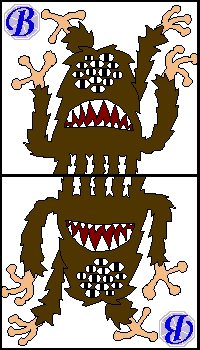 |
- When eights are not wild, a visible Sender of Eights makes any aces belonging to a player who uses any eights become zeroed.
- When eights are wild, a visible Sender of Eights zeroes all aces and disallows eights from taking on value one or eleven.
|
Modifier #9: Death’s Rules
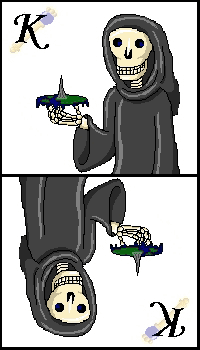 |
- When eights are not wild, a visible Death makes one picture card in every player’s hand that has two or more picture cards have no part in forming a Double Onion.
- When eights are wild, a visible Death makes one picture card in every player’s hand that has two or more picture cards have no part in forming either a Double Onion or a Triple Onion.
[The "killed" picture card can still take part in groups other than the specified Onions.]
|
Modifier #10: The Archchancellor’s Rules
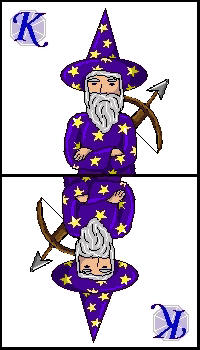 |
[Not yet implemented!]
- Any player who plays the Archchancellor may not also play an eight as having value eight.
- If the Archchancellor is declared at any time during the game, Death can also be declared if held by another player; if Death is declared, then all the other players must now declare one previously undisclosed card each. If Death is not immediately declared by another player, the the Archchancellor becomes wild for the rest of the round.
|
The Fool’s Rule
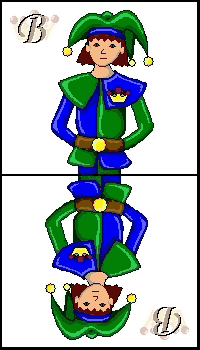 |
[Not yet implemented!]
If, at any time before Showdown, the Fool is declared, then, for for the rest of the round, bagels change places with Onions in the order of winning card groupings.
(That is: the two-card onion and the single bagel change places; the Double, Triple and Lesser Onions are exchanged with the double, triple and lesser bagels respectively; the great bagel becomes only beaten by, but may also be crippled like, the Great Onion which remains at the top of the list. This makes bagels worth something, other than a tie-breaker. The jack of clubs, of course, can still take part in bagels, and any other card grouping.)
|
5. Additional Comments:
Back
Cripple Mr Onion was first mentioned in Wyrd Sisters and has, since then, been seen in a number of places; the most notable of these, to date, is the section in Witches Abroad on the riverboat, and it is from this section that the game has been reconstructed.
Loosely speaking, it is a cross between pontoon (or blackjack) and poker, but played with a deck of cards having eight suits. Of course, the unusual nature of the Discworld has given Cripple Mr Onion features found in no other game.
Back
Original German translation
English version






